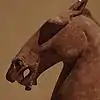Three Lords and Nine Ministers
The Three Lords and Nine Ministers system (Chinese: 三公九卿) was a central administrative system adopted in ancient China that was officially instituted in the Qin dynasty (221 BC – 206 BC) and was replaced by the Three Departments and Six Ministries (Chinese: 三省六部) system since the Sui dynasty (AD 589–618).
Divisions
Three Lords
Three Lords referred to three highest rank officials in the imperial government, namely:
- the Chancellor (丞相)
- the Imperial Secretary (御史大夫)
- the Grand Commandant (太尉)
Nine Ministers
Nine Ministers comprised all the ministers of importance in the central government. They were:
- the Minister of Ceremonies (太常, formally known as 奉常)
- the Supervisor of Attendants (光祿勛, formally known as 郎中令)
- the Commandant of Guards (衛尉)
- the Minister of Coachmen (太僕)
- the Commandant of Justice (廷尉)
- the Grand Herald (大鴻臚, formally known as 典客 or 大行令)
- the Director of the Imperial Clan (宗正)
- the Grand Minister of Agriculture (大司農, formally known as 治粟內史)
- the Small Treasurer (少府)
See also
References
Citations
- Wang 1949, pp. 150–151.
Sources
- Li, Konghuai (2007). History of Administrative Systems in Ancient China (in Chinese). Joint Publishing (H.K.) Co., Ltd. ISBN 978-962-04-2654-4.
- Lyu, Simian (2008). The General History of China (in Chinese). New World Publishing. ISBN 978-7-80228-569-9.
- Wang, Yu-Ch'uan (June 1949). "An Outline of The Central Government of The Former Han Dynasty". Harvard Journal of Asiatic Studies. Harvard-Yenching Institute. 12 (1/2): 134–187. doi:10.2307/2718206. JSTOR 2718206.CS1 maint: ref=harv (link)
This article is issued from Wikipedia. The text is licensed under Creative Commons - Attribution - Sharealike. Additional terms may apply for the media files.
